Capillary Barriers during Rainfall Events in Pyroclastic Deposits of the Vesuvian Area
Abstract
:1. Introduction
2. Pyroclastic Soils
3. Water Retention Properties
4. Infiltration Process
5. Results and Discussion
5.1. Infiltration Process
5.2. Stability Analyses
6. Conclusions
Author Contributions
Funding
Conflicts of Interest
References
- Khire, M.V.; Benson, C.H.; Bosscher, P.J. Capillary barriers: Design variables and water balance. J. Geotech. Geoenviron. Eng. 2000, 126, 695–708. [Google Scholar] [CrossRef] [Green Version]
- Rahardjo, H.; Satyanaga, A.; Leong, E.C. Unsaturated soil mechanics for slope stabilization. In Proceedings of the 5th Asia–Pacific Conference on Unsaturated Soils, Pattaya, Thailand, 29 February–2 March 2012; pp. 103–117. [Google Scholar]
- Pappalardo, L.; Piochi, M.; Mastrolorenzo, G. The 3550 YR BP-1944 AD magma-plumbing system of Somma-Vesuvius: Constraints on its behavior and present state through a review of Sr-Nd isotope data. Ann. Geophys. 2004, 47, 1471–1483. [Google Scholar]
- Pappalardo, L.; Mastrolorenzo, G. Short residence times for alkaline Vesuvius magmas in a multi-depth supply system: Evidence from geochemical and textural studies. Earth Planet. Sci. Lett. 2010, 296, 133–143. [Google Scholar] [CrossRef]
- De Vita, P.; Napolitano, E.; Godt, J.W.; Baum, R.L. Deterministic estimation of hydrological thresholds for shallow landslide initiation and slope stability models: Case study from the Somma-Vesuvius area of southern Italy. Landslides 2013, 10, 713–728. [Google Scholar] [CrossRef]
- Cascini, L.; Sorbino, G.; Cuomo, S.; Ferlisi, S. Seasonal effects of rainfall on the shallow pyroclastic deposits of the Campania region (southern Italy). Landslides 2014, 11, 779–792. [Google Scholar] [CrossRef]
- Urciuoli, G.; Pirone, M.; Comegna, L.; Picarelli, L. Long-term investigations on the pore pressure regime in saturated and unsaturated sloping soils. Eng. Geol. 2016, 212, 98–119. [Google Scholar] [CrossRef]
- Picarelli, L.; Olivares, L.; Damiano, E.; Darban, R.; Santo, A. The effects of extreme precipitations on landslide hazard in the pyroclastic deposits of Campania Region: A review. Landslides 2020, 17, 2343–2358. [Google Scholar] [CrossRef]
- Shackelford, C.D.; Chang, C.-K.; Chiu, T.-F. The capillary barrier effect in unsaturated flow through soil barriers. In Proceedings of the First International Congress on Environmental Geotechnics, Edmonton, AB, Canada, 10–15 July 1994; pp. 789–793. [Google Scholar]
- Mancarella, D.; Doglioni, A.; Simeone, V. On capillary barrier effects and debris slide triggering in unsaturated soil covers. Eng. Geol. 2012, 147–148, 14–27. [Google Scholar] [CrossRef]
- Damiano, E. Effects of layering on triggering mechanisms of rainfall-induced landslides in unsaturated pyroclastic granular soils. Can. Geotech. J. 2018, 56, 1278–1290. [Google Scholar] [CrossRef]
- Crosta, G.B.; Negro, P.D. Observations and modelling of soil slip-debris flow initiation processes in pyroclastic deposits: The Sarno 1998 event. Nat. Hazards Earth Syst. Sci. 2003, 3, 53–69. [Google Scholar] [CrossRef] [Green Version]
- Vingiani, S.; Mele, G.; De Mascellis, R.; Terribile, F.; Basile, A. Volcanic soils and landslides: A case study of the island of Ischia (southern Italy) and its relationship with other Campania events. Solid Earth 2015, 6, 783–797. [Google Scholar] [CrossRef] [Green Version]
- Reder, A.; Pagano, L.; Picarelli, L.; Rianna, G. The role of the lowermost boundary conditions in the hydrological response of shallow sloping covers. Landslides 2017, 14, 861–873. [Google Scholar] [CrossRef]
- Yang, H.; Rahardjo, H.; Leong, E.C.; Fredlund, D.G. A study of infiltration on three sand capillary barriers. Can. Geotech. J. 2004. [Google Scholar] [CrossRef]
- Sharma, R.H.; Nakagawa, H. Numerical model and flume experiments of single- and two-layered hillslope flow related to slope failure. Landslides 2010, 7, 425–432. [Google Scholar] [CrossRef]
- Mancarella, D.; Simeone, V. Capillary barrier effects in unsaturated layered soils, with special reference to the pyroclastic veneer of the Pizzo d’Alvano, Campania (Italy). Bull. Eng. Geol. Environ. 2011, 71, 791–801. [Google Scholar] [CrossRef]
- Pagano, L.; Reder, A.; Rianna, G. Experiments to Investigate the Hydrological Behaviour of Volcanic Covers. Procedia Earth Planet. Sci. 2014, 9, 14–22. [Google Scholar] [CrossRef] [Green Version]
- Tan, S.H.; Wong, S.W.; Chin, D.J.; Lee, M.L.; Ong, Y.H.; Chong, S.Y.; Kassim, A. Soil column infiltration tests on biomediated capillary barrier systems for mitigating rainfall-induced landslides. Environ. Earth Sci. 2018, 77, 589. [Google Scholar] [CrossRef]
- Oldenburg, C.M.; Pruess, K. On Numerical Modeling of Capillary Barriers. Water Resour. Res. 1993, 29, 1045–1056. [Google Scholar] [CrossRef]
- Stormont, J.C.; Morris, C.E. Method to Estimate Water Storage Capacity of Capillary Barriers. J. Geotech. Geoenviron. Eng. 1998, 124, 297–302. [Google Scholar] [CrossRef] [Green Version]
- Rahardjo, H.; Tami, D.; Leong, E.C. Effectiveness of sloping capillary barriers under high precipitation rates. In Proceedings of the 2nd International Conference on Problematic Soils, Selangor, Malaysia, 3–5 December 2006; pp. 39–54. [Google Scholar]
- Scarfone, R.; Wheeler, S.J.; Lloret-Cabot, M. A hysteretic hydraulic constitutive model for unsaturated soils and application to capillary barrier systems. Géoméch. Energy Environ. 2020. [Google Scholar] [CrossRef]
- Scarfone, R.; Wheeler, S.J.; Lloret-Cabot, M. Conceptual Hydraulic Conductivity Model for Unsaturated Soils at Low Degree of Saturation and Its Application to the Study of Capillary Barrier Systems. J. Geotech. Geoenviron. Eng. 2020, 146, 04020106. [Google Scholar] [CrossRef]
- Santacroce, R.; Cioni, R.; Marianelli, P.; Sbrana, A.; Sulpizio, R.; Zanchetta, G.; Donahue, D.J.; Joron, J.L. Age and whole rock–glass compositions of proximal pyroclastics from the major explosive eruptions of Somma-Vesuvius: A review as a tool for distal tephrostratigraphy. J. Volcanol. Geotherm. Res. 2008, 177, 1–18. [Google Scholar] [CrossRef]
- Sepe, C.; Calcaterra, D.; Di Martire, D.; Ramondini, M.; Russo, G.; Vitale, E.; Pappalardo, L. Role of capillary barriers in landslide susceptibility assessment in pyroclastic soils: Microstructure investigation and numerical analysis. Environ. Earth Sci. 2021, unpublished. [Google Scholar]
- De Vita, P.; Di Clemente, E.; Rolandi, M.; Celico, P. Engineering geological models of the initial landslides occurred on april 30 2006, at the Mount of Vezzi (Ischia island, Italy). Ital. J. Eng. Geol. Environ. 2007, 2, 119–141. [Google Scholar]
- Cruden, D.M.; Varnes, D.J. Landslide types and processes. In Landslides: Investigation and Mitigation; Turner, A.K., Schuster, R.L., Eds.; Transportation Research Board Special Report 247, National Research Council; National Academy Press: Washington, DC, USA, 1996; pp. 36–75. [Google Scholar]
- Bertagnini, A.; Landi, P.; Rosi, M.; Vigliargio, A. The Pomici di Base plinian eruption of Somma-Vesuvius. J. Volcanol. Geotherm. Res. 1998, 83, 219–239. [Google Scholar] [CrossRef]
- Pappalardo, L.; Buono, G.; Fanara, S.; Petrosino, P. Combining textural and geochemical investigations to explore the dynamics of magma ascent during Plinian eruptions: A Somma–Vesuvius volcano (Italy) case study. Contrib. Miner. Pet. 2018, 173, 61. [Google Scholar] [CrossRef]
- Buono, G.; Pappalardo, L.; Harris, C.; Edwards, B.R.; Petrosino, P. Magmatic stoping during the caldera-forming Pomici di Base eruption (Somma-Vesuvius, Italy) as a fuel of eruption explosivity. Lithos 2020, 370, 105628. [Google Scholar] [CrossRef]
- Arya, L.M.; Paris, J.F. A physicoempirical model to predict the soil moisture characteristic from particle size. Soil Sci. Soc. Am. J. 1981, 45, 1023–1030. [Google Scholar] [CrossRef]
- Cecconi, M.; Vecchietti, A.; Pane, V.; Russo, G.; Cencetti, C. Geotechnical Aspects in the Assessment of Stability Conditions of the Volumni Hypogeum in Perugia. In Geotechnical Research for Land Protection and Development, CNRIG 2019; Calvetti, F., Cotecchia, F., Galli, A., Jommi, C., Eds.; Lecture Notes in Civil Engineering 2020; Springer: Berlin/Heisenberg, Germany, 2020; Volume 40. [Google Scholar]
- Cecconi, M.; Cambi, C.; Carrisi, S.; Deneele, D.; Vitale, E.; Russo, G. Sustainable Improvement of Zeolitic Pyroclastic Soils for the Preservation of Historical Sites. Appl. Sci. 2020, 10, 899. [Google Scholar] [CrossRef] [Green Version]
- Van Genuchten, M.T. A closed-form equation for predicting the hydraulic conductivity of unsaturated soils. Soil Sci. Soc. Am. J. 1980, 44, 892–898. [Google Scholar] [CrossRef] [Green Version]
- Olivella, S.; Carrera, J.; Gens, A.; Alonso, E.E. Non isothermal multiphase flow of brine and gas through saline media. Transp. Porous Media 1994, 15, 271–293. [Google Scholar] [CrossRef]
- Olivella, S.; Gens, A.; Carrera, J.; Alonso, E.E. Numerical formulation for a simulator (CODE_BRIGHT) for the coupled analysis of saline media. Eng. Comput. 1996, 13, 87–112. [Google Scholar] [CrossRef] [Green Version]
- Mualem, Y. A new model for predicting the hydraulic conductivity of unsaturated porous media. Water Resour. Res. 1976, 12, 513–522. [Google Scholar] [CrossRef] [Green Version]
- Lu, N.; Likos, W.J. Unsaturated Soil Mechanics; Wiley: New York, NY, USA, 2004; ISBN 978-0-471-44731-3. [Google Scholar]
- Bilotta, E.; Cascini, L.; Foresta, V.; Sorbinow, G. Geotechnical characterisation of pyroclastic soils involved in huge flowslides. Geotech. Geol. Eng. 2005, 23, 365–402. [Google Scholar] [CrossRef]
- Vanapalli, S.K.; Fredlund, D.G.; Pufahl, D.E.; Clifton, A.W. Model for the prediction of shear strength with respect to soil suction. Can. Geotech. J. 1996, 33, 379–392. [Google Scholar] [CrossRef]
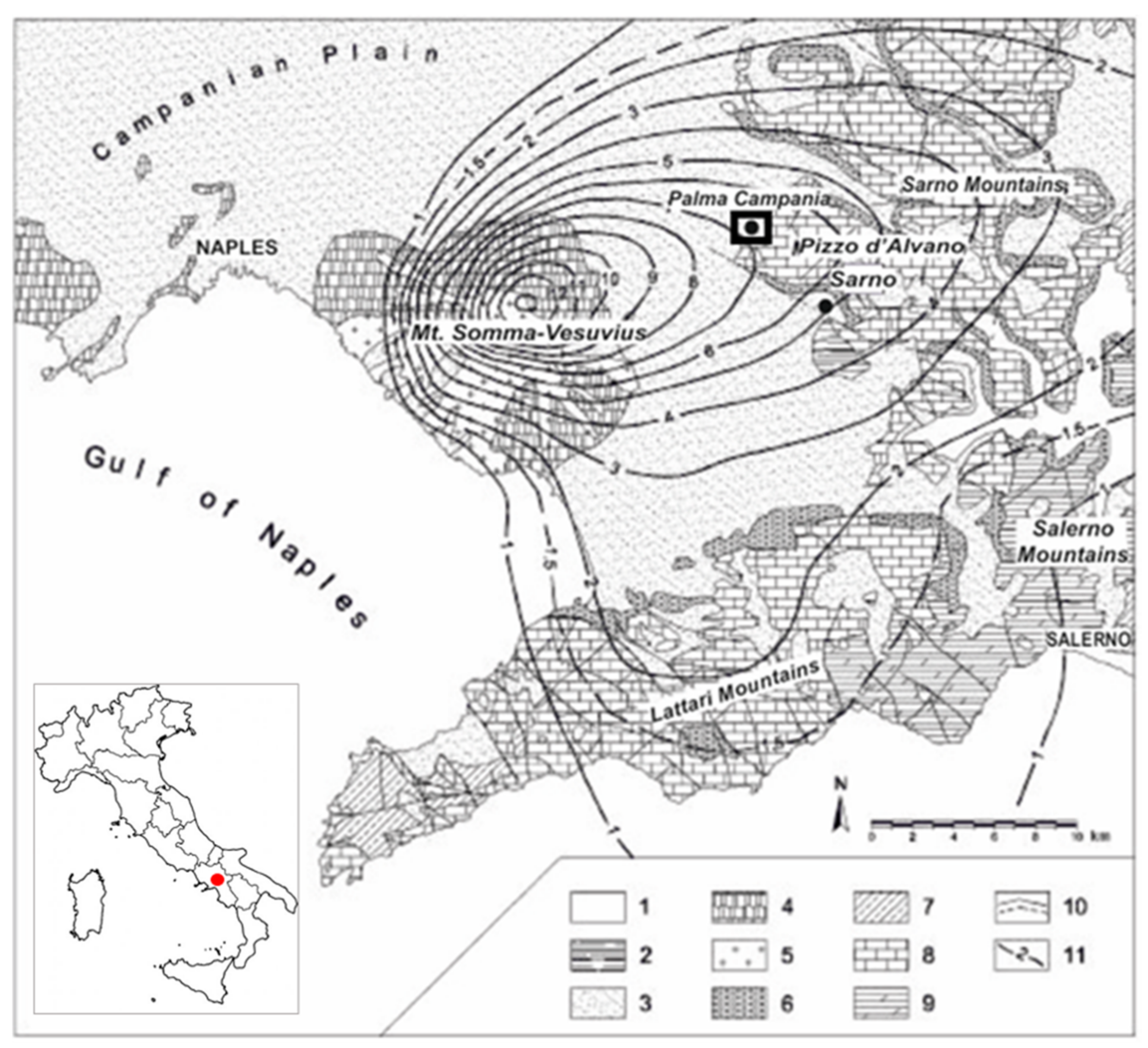


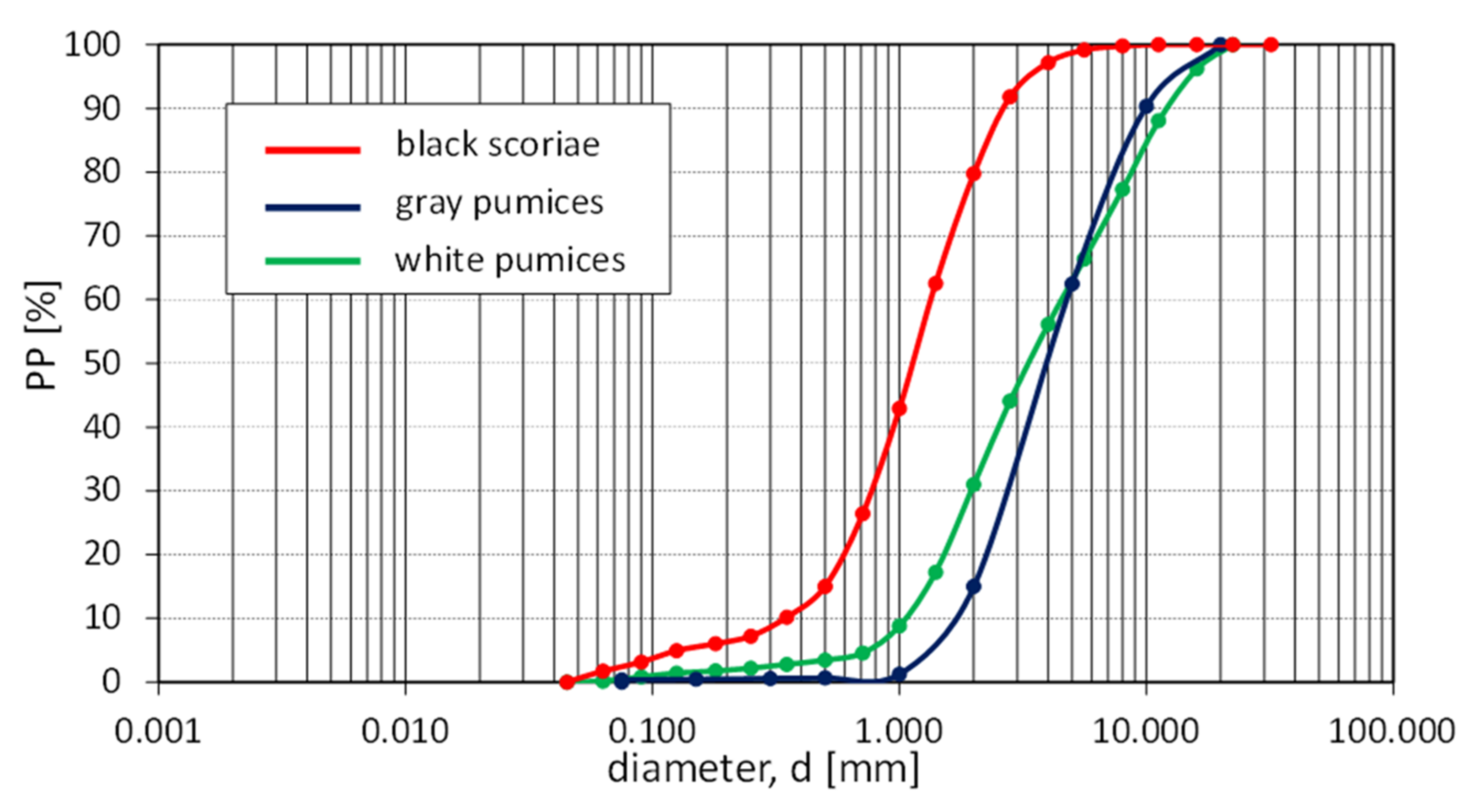
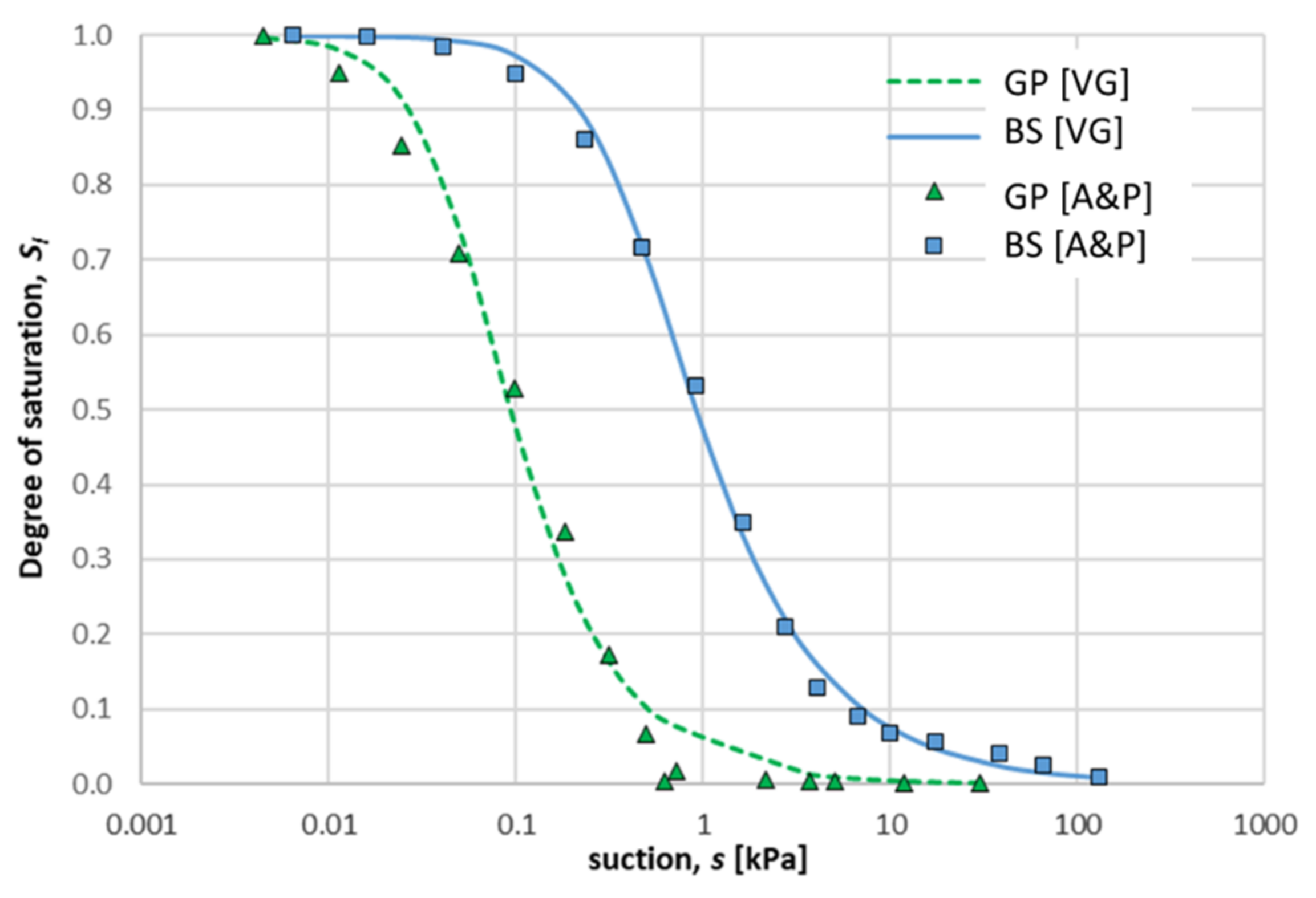

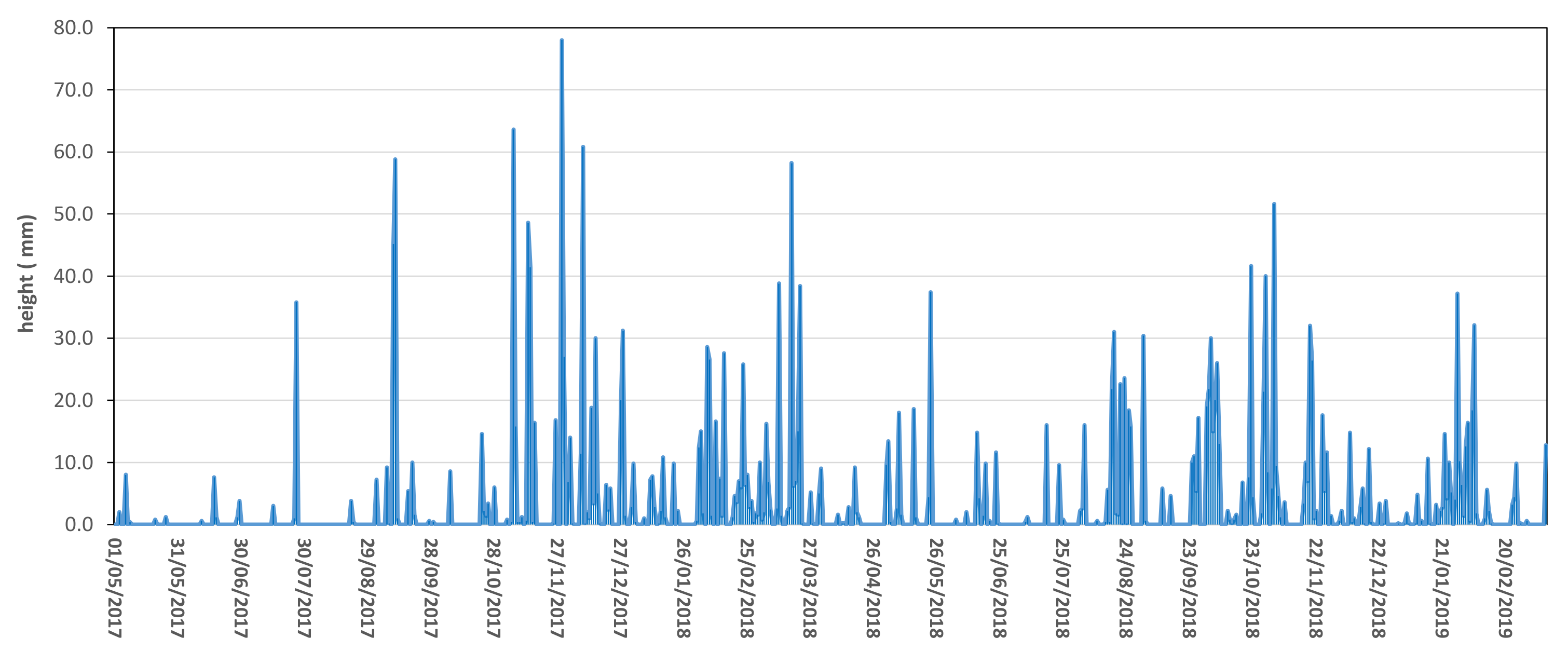
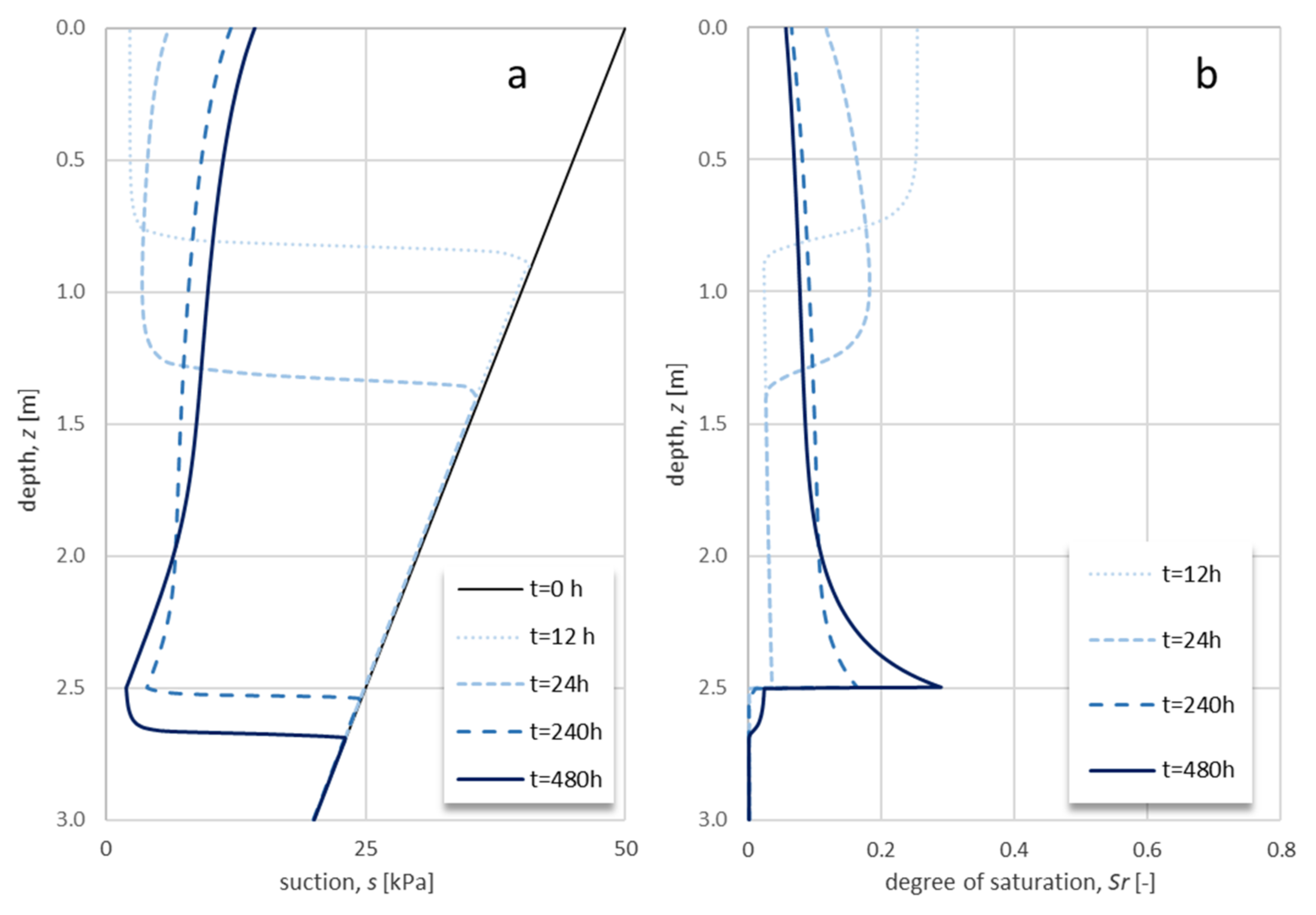

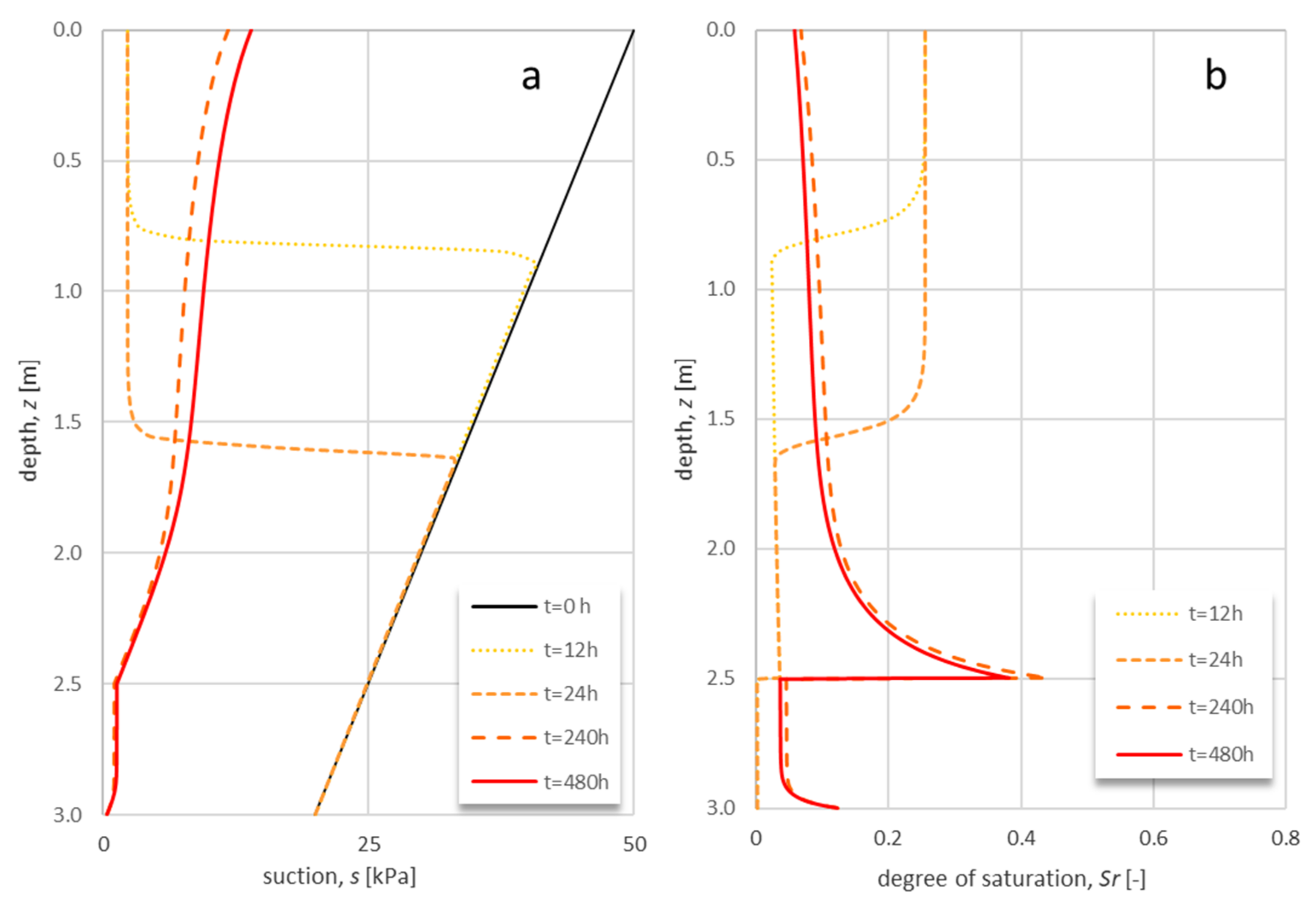

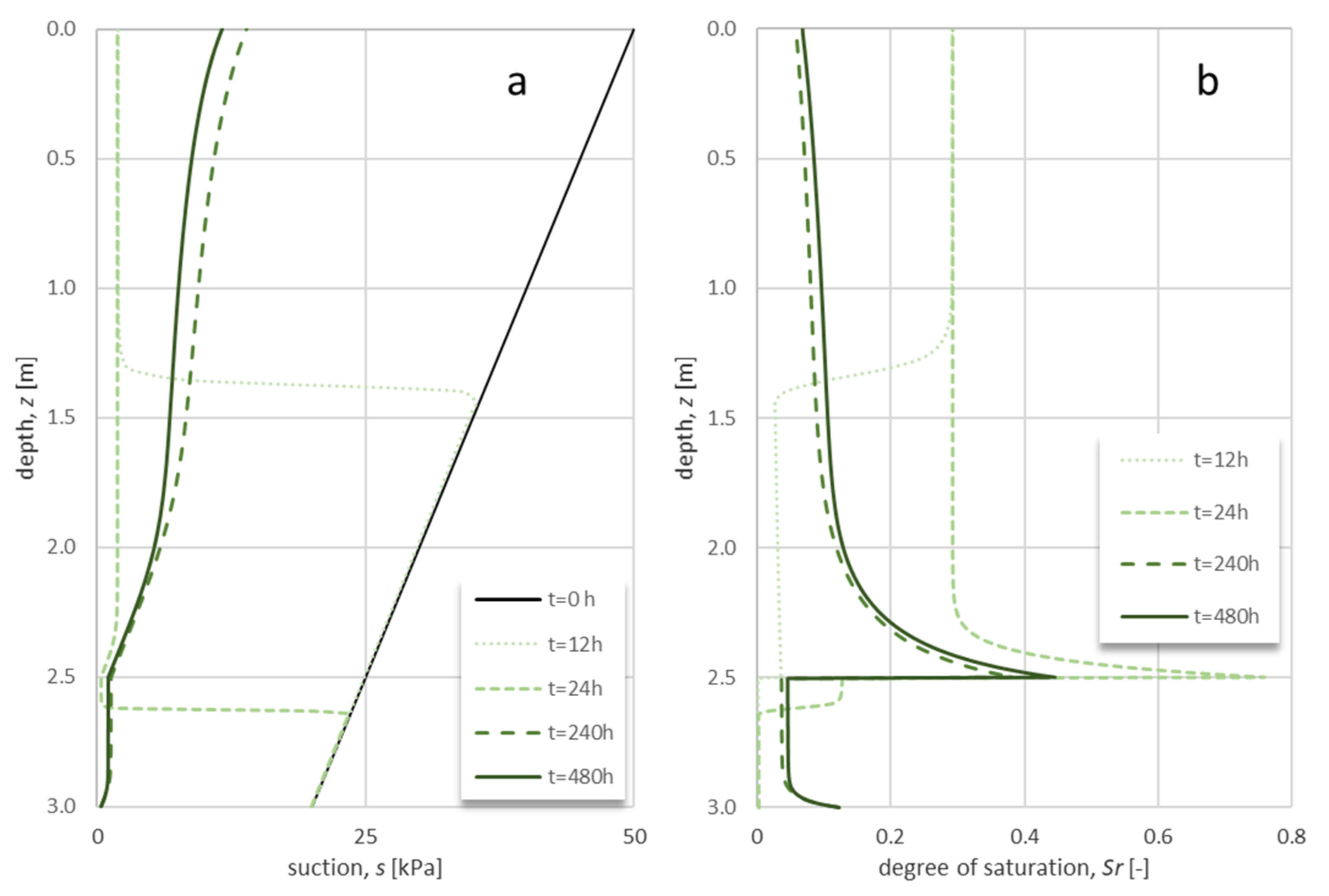
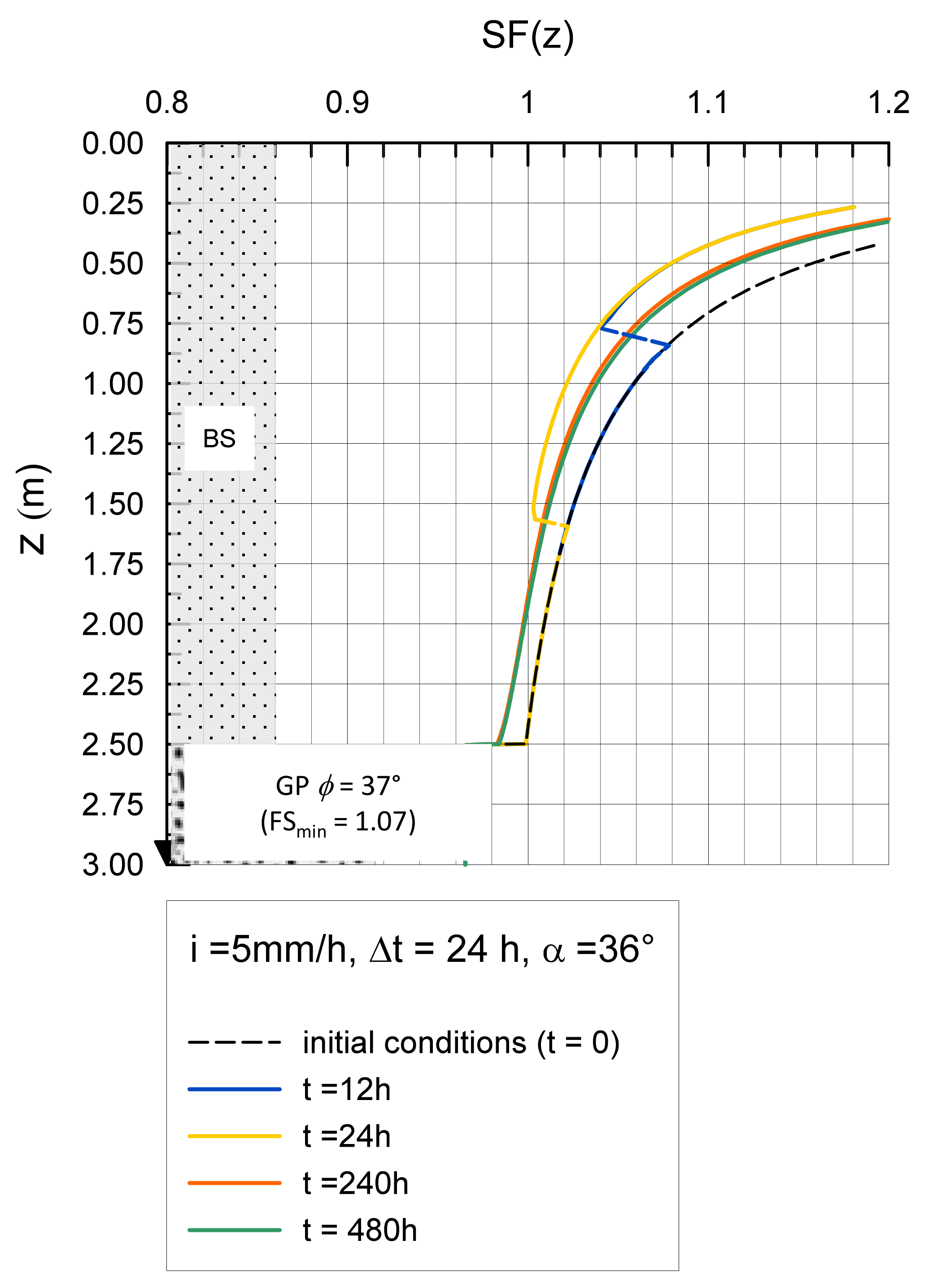
| This Study | Damiano et al. (2012) | De Vita et al. (2013) | Mancarella et al. (2012) | ||
|---|---|---|---|---|---|
| BS | GP | ||||
| a [kPa−1] | 2.2 | 18.1 | 3.3 | 4.2 | 28 |
| n | 1.8 | 2.0 | 7 | 1.43 | 2.5 |
| m | 0.5 | 0.5 | 0.5 | 0.3 | 0.6 |
| Sr | 0 | 0 | 0.5 | 0 | 0 |
Publisher’s Note: MDPI stays neutral with regard to jurisdictional claims in published maps and institutional affiliations. |
© 2021 by the authors. Licensee MDPI, Basel, Switzerland. This article is an open access article distributed under the terms and conditions of the Creative Commons Attribution (CC BY) license (https://creativecommons.org/licenses/by/4.0/).
Share and Cite
Sepe, C.; Calcaterra, D.; Cecconi, M.; Di Martire, D.; Pappalardo, L.; Scarfone, R.; Vitale, E.; Russo, G. Capillary Barriers during Rainfall Events in Pyroclastic Deposits of the Vesuvian Area. Geosciences 2021, 11, 274. https://doi.org/10.3390/geosciences11070274
Sepe C, Calcaterra D, Cecconi M, Di Martire D, Pappalardo L, Scarfone R, Vitale E, Russo G. Capillary Barriers during Rainfall Events in Pyroclastic Deposits of the Vesuvian Area. Geosciences. 2021; 11(7):274. https://doi.org/10.3390/geosciences11070274
Chicago/Turabian StyleSepe, Ciro, Domenico Calcaterra, Manuela Cecconi, Diego Di Martire, Lucia Pappalardo, Riccardo Scarfone, Enza Vitale, and Giacomo Russo. 2021. "Capillary Barriers during Rainfall Events in Pyroclastic Deposits of the Vesuvian Area" Geosciences 11, no. 7: 274. https://doi.org/10.3390/geosciences11070274
APA StyleSepe, C., Calcaterra, D., Cecconi, M., Di Martire, D., Pappalardo, L., Scarfone, R., Vitale, E., & Russo, G. (2021). Capillary Barriers during Rainfall Events in Pyroclastic Deposits of the Vesuvian Area. Geosciences, 11(7), 274. https://doi.org/10.3390/geosciences11070274









